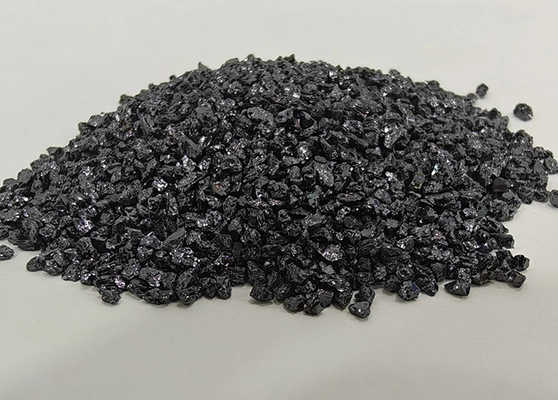Carborundum (Silicon Carbide, SiC): Quick Answer
Carborundum is the trade/common name for silicon carbide (SiC), an ultra-hard ceramic (Mohs ≈ 9.2–9.5) used as abrasive grain (grinding wheels, coated abrasives, blasting), refractory aggregate, and advanced ceramics/semiconductors. It features high thermal conductivity, chemical inertness, and stability at high temperatures. Industrial SiC is typically produced by the Acheson process (quartz + carbon, electric resistance furnace) and supplied as black SiC (tougher, for general grinding/blasting) or green SiC (sharper, higher purity, for hard/brittle materials).
- Use it when: Need aggressive cutting/long life on hard metals, ceramics, glass/stone, or as refractory/phosphor/ceramic feedstock.
- Choose black vs green: Black = toughness/value; Green = sharpness/purity/fine lapping.
- Key specs: FEPA/JIS grit, purity (%SiC), PSD (D10/D50/D90), magnetic content, bulk density, washing (acid/water), shape.
What Is Carborundum?
Carborundum is the historical/industrial name for silicon carbide (SiC), discovered in the late 19th century and commercialized as a synthetic abrasive. Today it spans two major domains: (1) abrasives & refractories (bulk grains, powders) and (2) electronic-grade SiC (single-crystal/polycrystalline for power devices).
In abrasives/refractories, SiC is valued for hardness, sharp edges, thermal conductivity, and chemical stability. Typical product families: Black SiC (tough, value) and Green SiC (higher purity, sharper).
Key Properties & Parameters (incl. 3C/4H/6H Polytypes)
SiC has many polytypes; for engineering selection, 3C-SiC (cubic), 4H-SiC (hexagonal), and 6H-SiC are common references. Abrasive grains are typically polycrystalline with stacked variants; electronics favor 4H/6H wafers for their wide bandgaps.
| Parameter | Black SiC (Abrasive) | Green SiC (Abrasive) | 3C-SiC (β-SiC) | 4H-SiC | 6H-SiC |
|---|---|---|---|---|---|
| Mohs Hardness | ≈ 9.2–9.5 | ≈ 9.3–9.5 | ≈ 9.3 | ≈ 9.3 | ≈ 9.3 |
| Crystal System | Polycrystalline | Polycrystalline | Cubic (zinc blende) | Hexagonal | Hexagonal |
| Typical Purity (abrasive grade) | ≈ 97–99% SiC | ≈ 98.5–99.5% SiC | High (electronics R&D) | Electronic grade (very high) | Electronic grade (very high) |
| Density (theoretical) | ~3.20–3.22 g/cm³ | ~3.21–3.22 g/cm³ | |||
| Thermal Conductivity | High (material & grit dependent) | High | High | High | |
| Bandgap (room temp., electronics) | — | ~2.3–2.4 eV | ~3.2–3.3 eV | ~3.0–3.1 eV | |
| Typical Uses | Grinding, blasting, refractories | Lapping, precision grinding, glass/ceramics | Thin films, MEMS research | Power electronics (MOSFETs, diodes) | Power electronics, substrates |
* Data are representative engineering ranges. For procurement, specify target purity, PSD, and inspection methods.
Manufacturing Routes & Supplied Forms
Manufacturing Routes
- Acheson Process: Quartz + carbon in electric resistance furnaces → bulk SiC crystal mass → crushed → classified.
- Reaction-Bonded (RB-SiC): Porous preforms infiltrated with Si → SiC matrix; high stiffness, complex shapes.
- Sintered SiC (SSiC): Fine powders, pressureless or hot-pressed → high strength, corrosion/thermal shock resistance.
- CVD/CVI SiC: High-purity coatings or monolithic deposits for optics/severe environments.
- Electronic-grade SiC: Sublimation growth (PVT) → 4H/6H single crystals; wafering/polishing for devices.
Supplied Forms (Abrasives/Refractories)
- Macro grits (FEPA F/P series; e.g., F12–F220 / P12–P220)
- Micro powders (F230–F1200 / P240–P5000; JIS #240–#8000)
- Refractory aggregates (0–25 mm graded)
- Washing: water-wash / acid-wash grades;Magnetic-controlled grades
Selection Checklist
- Application: grinding/bonded wheel, coated abrasive, blasting, lapping, refractory, ceramic part?
- Material to cut: ferrous/non-ferrous, glass/ceramic, stone, hard alloys → choose black vs green & grit range.
- Grit standard: FEPA F/P, JIS; nominal grit + PSD (D10/D50/D90) + sieve curve.
- Purity: %SiC, free Si/C, total Fe, Ca, Al, magnetic content (ppm).
- Shape & friability: blocky vs angular; crushing route affects cutting behavior.
- Surface treatment: water/acid wash;binder-compatibility treatments (for wheels/coated).
- Regulatory & docs: COA, MSDS, REACH, RoHS; lot traceability.
- Logistics: packaging (25 kg bags, jumbo bags), moisture control, palletization, INCOTERMS.
Comparisons & Application Guidance
| Material | Pros | Cons | Typical Uses |
|---|---|---|---|
| Black SiC | High toughness, value, good for general grinding/blasting | Less sharp than green, slightly lower purity | Foundry, steelworks, blast media, bonded wheels |
| Green SiC | Higher purity, sharper edges, excels on hard/brittle substrates | Higher price, more brittle | Glass/ceramics lapping, precision grinding, carbide tools |
| Aluminum Oxide | Tough, widely available, cost-effective | Softer; slower on very hard substrates | General metal grinding/polishing |
| CBN | Excellent on ferrous alloys; thermal stability | Costly; specialized bonds/equipment | HSS, bearing steels finishing |
| Diamond | Hardest; fastest cut on hard/brittle non-ferrous | Reacts with Fe at high temp; cost | Carbide, glass, stone, composites |
Rule of thumb: For ferrous metals → Black SiC or CBN; for glass/ceramics/carbide → Green SiC or Diamond.
Procurement & QA Points
- Specify standard: FEPA/JIS/ANSI;state grit & PSD tolerances, test methods (laser diffraction / sieving).
- Impurity control: Total Fe, free Si/C, magnetic content; ask for acid-wash when necessary.
- COA per lot: Purity, PSD curve, bulk density, LOI, moisture, magnetic (ppm).
- Trial lots → scale: Approve on 100–500 kg before 10–30 t/mo contracts.
- Packaging & storage: Moisture barrier bags, desiccants, FIFO.
FAQ
Is carborundum the same as silicon carbide?
Yes. “Carborundum” is the traditional industrial name for silicon carbide (SiC).
Black vs Green SiC — which should I choose?
Black for general grinding/blasting and value; Green for high-purity, sharp cutting of hard/brittle materials and fine lapping.
Which grit standard should I order?
Use FEPA F/P or JIS depending on your plant spec. Always define PSD (D10/D50/D90) and acceptable tolerance bands.
What about electronic-grade SiC (4H/6H)?
That refers to single-crystal wafers for power electronics; it’s outside abrasive grades but shares core material physics.
References
- Standard references on SiC materials science (textbooks, handbooks) and FEPA/JIS grit standards.
- Manufacturers’ COA/QA methods for abrasive SiC macro & micro grades.
- Engineering data on 3C/4H/6H polytype properties used in device and materials selection.
